
by Glenn B. Stracher Thursday, January 5, 2012
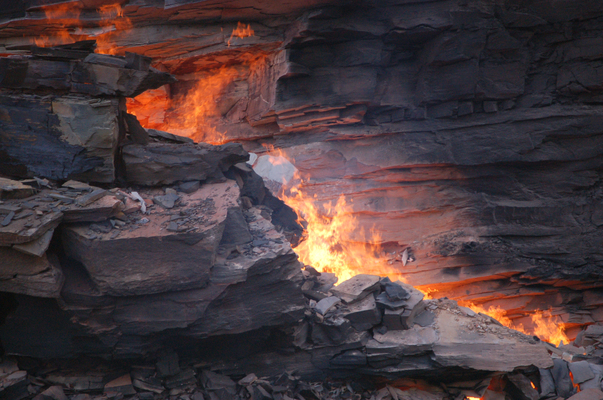
Coal fires cause pollution and ground subsidence at the world's largest coal-fire complex near Jharia, India. Anupma Prakesh
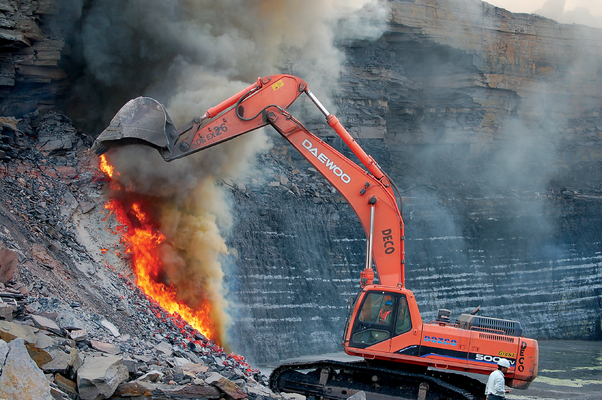
Bulldozers remove burning coal from the coal fires at Jharia. Anupma Prakash
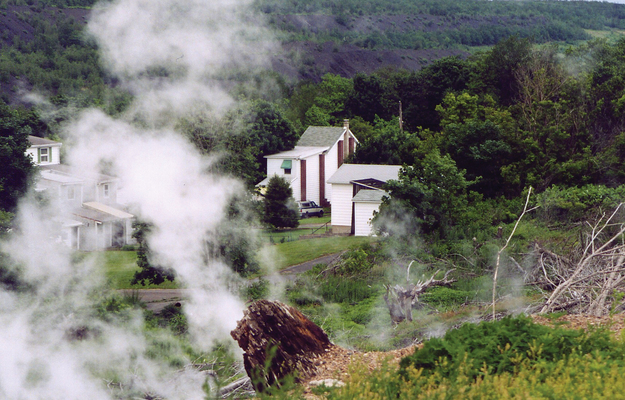
Only a few homes remain in Centralia, Pa., where an underground coal fire has been burning since 1962. Janet L. Stracher
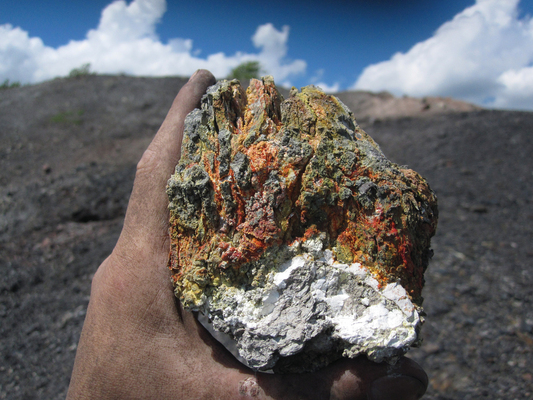
Byproducts of combustion - potassium, iron and calcium sulfates - from the Anna coal mine dump near Aachen, Germany. Frank de Wit
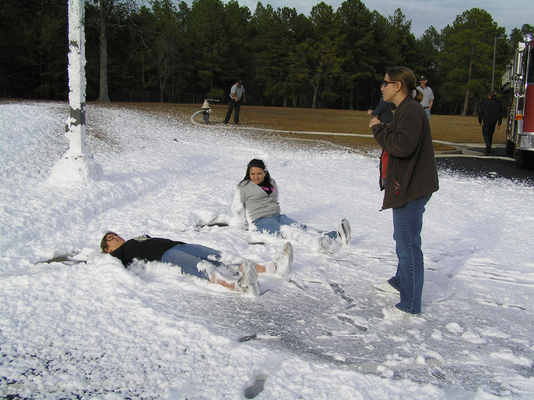
Compressed air foam is used to extinguish a gob or underground coal fire. Janet L. Stracher
In eastern India, north of the Damodar River, approximately 70 fires are burning in the Jharia coalfield, the largest coalmine fire complex in the world. The majority of fires in Jharia ignite when coal, exposed to air during mining operations, spontaneously combusts. Particulate matter and noxious gases emitted from the burning coal — including sulfur, carbon and nitrogen oxides, and hydrocarbons released at the surface from gas vents, ground fissures and the soil — have caused illnesses that range from stroke to chronic obstructive pulmonary disease. Occasionally the ground collapses, swallowing buildings and people into the abyss. To escape these dangers, entire communities have been relocated by the Indian government.
Since the first reported fire in Jharia started in 1916, at least 37 million tons of coal have been consumed in the inferno, reaching temperatures as high as 731 degrees Celsius. It is estimated that close to 1.5 billion tons of coal are inaccessible due to burning. Jharia will continue to burn until effective fire prevention and extinguishment procedures are developed and emplaced or the coal burns itself out. Considering how much coal has burned since 1916, if all of the remaining inaccessible amount were to burn at the same average rate, the fires could last for another 3,800 years.
And the fires in Jharia are hardly the only coal fires in the world.
Thousands of coal fires are reported to be burning in at least 22 countries on every continent except Antarctica. In the U.S., more than 100 underground fires are burning in at least nine states, including Colorado, Kentucky, Maryland, New Mexico, Pennsylvania and Wyoming.
Meanwhile, surface coal fires are also burning in at least 13 states. Some of these fires have been burning for decades — and like the fires at Jharia, there’s little that can or has been done to permanently extinguish them. All of these fires are of global importance: They destroy a valuable energy source; obliterate ecosystems and human communities; emit dangerous toxins, particulate matter and metals; and release greenhouse gases into the atmosphere. Given the enormity and prevalence of the problem, it’s essential that we inventory and study these fires, as well as inform the general public about the dangers such fires pose. It is also imperative that we develop cost-effective strategies for preventing, extinguishing or containing these fires to prevent human illnesses and the destruction of ecosystems.
From India to Australia to the United States, coal fires have obliterated ecosystems while partially, if not entirely, destroying entire communities. In 2002, for example, a forest fire broke out on the western slope of South Canyon, west of Glenwood Springs, Colo. The U.S. Forest Service suggests that the fire started when vegetation was ignited by hot cinders or a spark from a gas vent associated with the underground South Cañon Number 1 Mine fire, burning beneath the slopes of the canyon since 1910. Before it was extinguished, the forest fire consumed more than 4,800 hectares of forest and destroyed 29 homes and 14 other buildings located in and near Glenwood Springs. But the fire underground continues to burn, never having been extinguished.
Then, there is the famous Centralia, Pa., coal fire that has been burning since 1962; it was ignited by a landfill that was burned to reduce its volume and control rodents. Today, Centralia is on the verge of becoming a ghost town, with only a handful of residents remaining after the government declared the area unsafe in the 1980s and bought out the land from those residents who were willing to leave. Likewise, in Jharia, the government of India has provided relocation funds for displaced residents.
In Mulga, Ala., in a valley about a 20-minute drive northwest of Birmingham, a different sort of fire has burned. “Gob piles” almost 10 stories high were deposited at the surface on a hectare of land during underground mining between 1908 and 1983. A gob pile (also known as a boney pile, slate dump, culm bank, coal refuse pile, coal waste bank or spoil pile) is coal-mining refuse of no commercial value at the time the coal was mined. It typically consists of waste rock and fragments of coal that are uneconomical to separate from the waste.
In 1989 or 1990, coal in a Mulga gob pile ignited when people burned garbage on the refuse pile. Within three months of ignition, state officials thought the fire burned itself out after the combustion “hot spot” was buried beneath soil. Then in 2006, the fire reignited and spread extensively throughout the refuse pile, possibly by spontaneous combustion. Gas from the burning coal in the gob pile could be smelled in and around Mulga, resulting in respiratory complaints. In addition, the number of early morning traffic accidents increased in the valley because morning fog mixed with coal-fire gas and smoke, considerably reducing visibility. After the fire reignited, workers with the Alabama Abandoned Mine Reclamation Program buried the refuse pile beneath a meter of soil. The fire was reportedly extinguished in March 2010. However, the pile may be smoldering at depth and, as is the case with so many buried refuse piles, may reignite with visible evidence at the surface, including smoke, flames, ground fissures and the smell of coal-fire gas. But the threat coal fires pose goes beyond simply flames and smoke; the toxins they release may be the most worrisome hazard of all.
There are numerous causes for the coal fires that burn at or below Earth’s surface, including lightning strikes, forest fires, spontaneous combustion, mining or other accidents and even arson. Such fires produce a variety of adverse environmental effects. The most immediate and obvious are the destruction of wildlife ecosystems and the deterioration or total destruction of once-thriving human communities, due to pollution and ground subsidence caused by the volume reduction in coal as it burns, as has happened in Jharia, where an undisclosed number of people have died. But the effects reach far beyond Jharia.
Coal-fire gas typically contains between 40 and 50 different compounds, many of which are toxic and some of which are carcinogenic. These compounds, such as benzene, hydrogen sulfide and carbon monoxide, to name just a few, have killed people or made them sick. In northern China, studies have shown that toxic gas and particulate matter from coal fires are responsible for pulmonary heart disease, bronchitis, chronic obstructive pulmonary disease, stroke and lung cancer.
Coal fires also contribute carbon dioxide, methane and mercury to the atmosphere. Although some rudimentary calculations in 1995 by Craig Cassells and John van Genderen from the International Institute for Geo-Information Science and Earth Observation in the Netherlands suggested that coal fires may account for as much as 2 to 3 percent of annual atmospheric carbon dioxide emissions, no reliable global estimates are currently available for the various coal-fire gas components, particulate matter and mercury. Furthermore, such fires also contribute compounds destructive to the ozone layer, including ethane, ethene, propane and propene. Although the extent of ozone deterioration from these coal-fire compounds has never been quantified, it is possible that the emissions from thousands of coal fires burning around the world could have a detrimental effect on Earth’s ozone layer, and in addition, could contribute significantly to the greenhouse effect.
Solids also nucleate from coal-fire gas. These may include creosote, composed of toxic polycyclic aromatic hydrocarbons nucleated from bituminous-coal-fire gas. In addition, numerous other solid phases nucleate from the gas, some of which may contain potentially harmful concentrations of mercury, lead, fluorine, selenium, arsenic, bismuth and tin. These materials can pollute the local water system as well as the soil, potentially leading to diseases such as arsenic, fluoride, lead or mercury poisoning.
In the U.S., scientists from federal and state agencies, academia and private industry recently formed a coalition to quantify some of the dangers of living near coal fires. Specifically, these scientists, including the author, are investigating gas and mercury emission rates from select coal fires in the U.S. The coalition has thus far collected and processed (or is processing) data from the Mulga gob fire in Alabama; the Ruth Mullins, Truman Shepherd and Tiptop fires near the town of Hazard in eastern Kentucky; and the Welch Ranch fire, about 10 minutes north of Sheridan, Wyo., in the Powder River basin (plus other select localities in Wyoming). From these fires, scientists are characterizing coal-fire gas emissions and the minerals and creosote nucleated from the gas. The news so far isn’t good.
The Tiptop underground coal fire in Breathitt County, Ky., typifies the results. No one seems to know how long it’s been burning, how much coal it has consumed, how it started or the dangers associated with it. The origin of this fire possibly occurred before mining ended at Tiptop some 80 years ago. Whatever has been leaking out of this inferno has been doing so for a long time.
In May 2008 and January 2009, a team measured the emissions and metals in the area. The carbon monoxide emissions reached 600 parts per million (ppm) in May and more than 700 ppm in January whereas the carbon dioxide emissions were 2 percent by volume and then over 6 percent by volume. These concentrations exceed the U.S. Occupational Safety & Health Administration’s (OSHA) eight-hour safe exposure limits of 50 ppm of carbon monoxide and 0.5 percent by volume of carbon dioxide. Mercury was detected at greater than 500 and 2,100 micrograms per cubic meter in May and January, respectively, exceeding the OSHA eight-hour exposure limit of 50 micrograms per cubic meter. During both sampling periods, the team also found numerous volatile organic and carbon-sulfur compounds, including benzene, toluene, ethylbenzene and xylene. Although these compounds were in the parts-per-billion range, prolonged exposure could be harmful, causing anything from respiratory problems to cancer, as has happened in China.
Coal fires are likely to increase in the future, as the global demand for coal, a relatively inexpensive and accessible fuel, continues to rise to meet the growing needs of technologically advanced and developing nations. The number of coal fires reported in peer-reviewed journal articles published in English has increased from about 20 in the mid-1950s to more than 70 since the 1980s, in addition to the untold number of coal fires reported in abstracts, books and university theses written in languages varying from Russian to Spanish to Chinese.
As such, numerous researchers from around the world have come together at several symposia and conferences over the past six years to share research and talk about solutions. The problem, unlike with forest fires that are usually extinguished as quickly as possible, is that coal fires may burn for decades as in the United States, for hundreds of years as in China, or for thousands of years as in Australia, where the oldest-known coal fire, Burning Mountain, has been ablaze for the past 6,000 years.
Extinguishing a coal fire requires eliminating one of the three agents of the “fire triangle” that supports combustion — fuel, oxygen and heat energy. But this often proves impossible for a number of reasons: funds may not be available to fight the fire; the fire may be inaccessible due to its intensity and the risks involved like ground subsidence and smoke; the fire may occur in a maze of underground coal seams or mining tunnels that stretch for tens or hundreds of kilometers; or, in the case of a gob pile, the soil surface seal that snuffs out the fire usually fails within three years, so it has to be maintained to prevent oxygen from reaching the coal while it cools below the ignition temperature. A maintenance period of at least 20 years may be necessary to ensure that a gob pile is fully extinguished. In fact, coal inside a gob pile can smolder for years with super low oxygen concentrations.
When firefighters do try to extinguish a coal fire, the process is expensive, time-consuming and labor-intensive. Some of the most common methods to fight such a fire include digging it out by hand or with machinery and quenching it with water, or sealing it off in underground tunnels using bricks, fly ash or other material to starve the fire of oxygen. When underground coal seams occur in rocks that contain numerous joints, faults and folds, however, it may be impossible to starve the fire of oxygen and extinguish it. For gob fires, firefighters often try digging fire breaks around the gob pile and burying it beneath a fly ash or clay seal, which must be maintained for years.
More recently, other technologies have been employed to fight coal fires, such as firefighting foam like that used by the Compressed Air Foam Systems Company (CAFSCO) in Joshua, Texas, whose foam can migrate deep into underground mining tunnels, joints and faults and suffocate a coal fire by depriving it of oxygen. Another option involves cellular grout, a technique that works similar to the foam, employed by Goodson and Associates, Inc., in Wheat Ridge, Colo. And government agencies in different countries have fought underground and gob fires by injecting them with cryogenic liquefied gases like carbon dioxide and nitrogen to absorb the heat energy necessary for combustion while producing an inert atmosphere. Although the newer technologies have generally worked, there are reported cases of failures, and in many cases, they are cost-prohibitive to use. They need to thus be used in conjunction with new technologies that need to be developed.
The rising global interest in coal fires is in response to scientific awareness about the wide variety of toxic and potentially toxic effects of these fires. Because both short- and long-term exposure to even low-level emissions may threaten human health and wildlife ecosystems, it is important that scientists quantify these effects — the more we know about coal fires, the better we can protect ourselves and our environment.
© 2008-2021. All rights reserved. Any copying, redistribution or retransmission of any of the contents of this service without the expressed written permission of the American Geosciences Institute is expressly prohibited. Click here for all copyright requests.